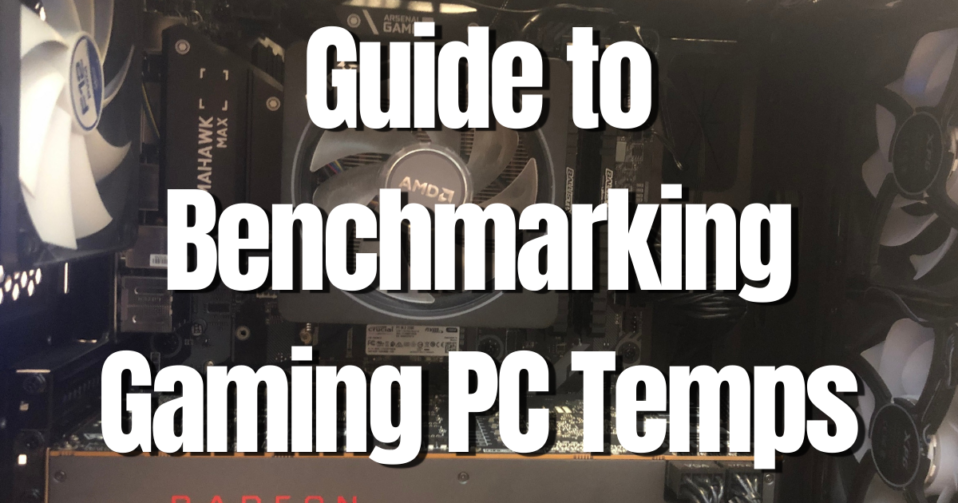
You’ve set up your brand new gaming PC build or perhaps you’ve had your old clunker sitting around for a while and are wondering if you need to beef up its cooling — then you might want to benchmark or test out your gaming PC’s temperatures.
This is where you might be wondering how do you do this and which temperatures matters. After all, you may want to test your CPU, graphics card or internal case temps. Even within each of those, you may see different temperatures that speak to individual CPU cores or different parts of your graphics card for example.
So today, let’s go through a few questions you may have when wanting to check out your Gaming PCs temps, talk a little bit about what may or may not be ideal temperatures and how you can benchmark your gaming pc temps if you are planning to upgrade your current PCs cooling (whether it be adding new fans, a new CPU cooler or AIO as examples).
Do keep in mind that testing pc case thermals isn’t necessarily a perfect science and there are many variables that can have an effect on your tests. With that being said, doing a decent test is possible if you follow a stringent procedure testing one variable at a time while keeping everything as constant as you can. Since most of us are probably gaming pc enthusiasts, use this guide as a flexible how to get started benchmarking your gaming pc temperatures guide and have fun testing out your own hardware doing so.
- Gaming PC Used to Benchmark Temps
- Getting Started: How to Check Your Gaming PCs Temps and What Software Can You Use?
- What are Ideal Temps for Your Gaming PC and What Temps Matter?
- What Software Can You Use to Benchmark Your Gaming PC Temps?
- How to Benchmark Your Gaming PCs Temperatures
Gaming PC Used to Benchmark Temps
To give you an idea of how I’ll be measuring temps, for every test you see here, the test setup I’m using consists of the following Gaming PC hardware:
- CPU: Ryzen 7 3700X CPU.
- Cooling: A stock AMD Wraith Stealth Cooler.
- GPU: AMD RX 5700 GPU, reference model with a blower fan.
- Memory: 16GB of Crucial Ballistix MAX DDR4 4000 memory.
- Motherboard: MSI B450 Tomahawk Max Motherboard.
- Case: Coolermaster 175R PC Case with five 120mm Fans Installed (three 120mm 12V intakes on the front, and one 120mm 12V on the back as exhaust and one 12V 120mm on the back top as an exhaust).
- Power Supply: 650W EVGA power supply.
To test, I have all case fans running at 50% and default fan curves set for the GPU and Wraith Prism Cooler and an Ambient Room temperature of 20°C.
How to Check Your Gaming PC Temps: Software to use
To get started, if you want a very basic way of looking at every single temp at a glance, then I suggest downloading HWiNFO. Through this software, you’ll be able to immediately check out every single temp that you have access to reading on your current gaming pc using any motherboard.
To see a quick overview of all of your PC’s temperature sensors, first, download HWiNFO, extract and open. Then upon first starting the software, you’ll see the initial dashboard, so what you’ll want to click first is the “Sensors” icon in the top menu, and then click on the bottom right “Configure Sensors” gear icon.
From there, under where it says “Show Values“, unclick everything except “Temperatures” and “Fans“.
And now, you should see just a list of every single temperature sensor on your Gaming PC as such:
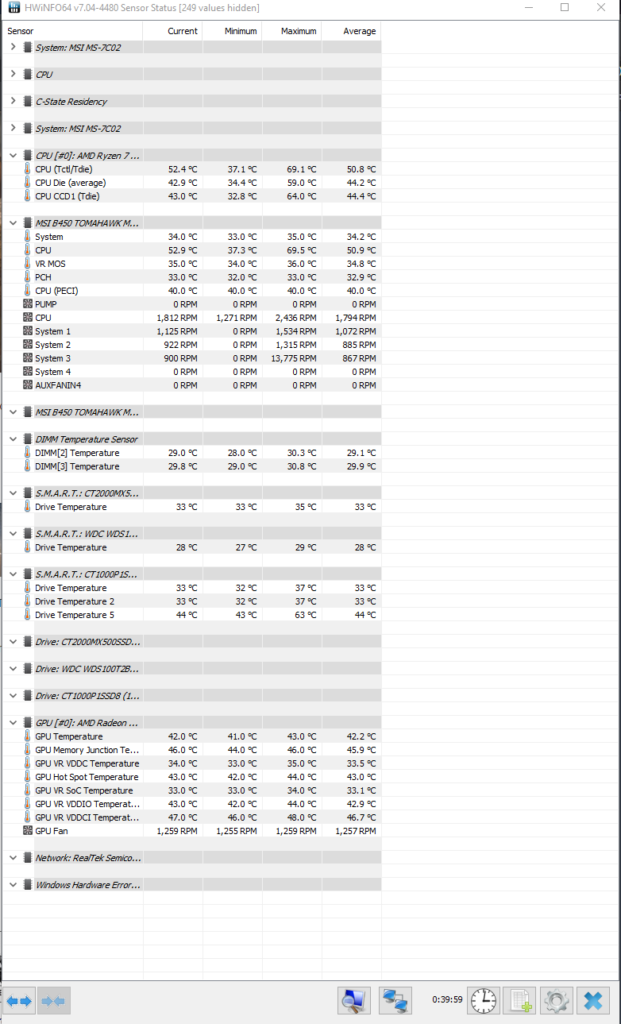
As seen above, you can see that there are multiple ways we can read the PCs temps and see how your case fans are operating in terms of their RPM (rotations per minute).
Another piece of software that I highly recommend for not only monitoring but for benchmarking your gaming PC temps (and monitoring every other performance indicator on your gaming PC), is MSI AfterBurner.
And thirdly, each motherboard manufacturer typically has a proprietary software specific to their boards that you can use to fine-tune your PCs performance (including CPU/GPU/Memory overlcocking, setting PC fan speeds and monitoring PC performance), such as the ones below. If you motherboard brand isn’t included, then I recommend one of the above software for monitoring anyhow. Your motherboards software will be good for setting cooling fan speeds, and seeing immediate temperatures for basic sensors, however it most likely won’t have a good benchmarking tool built in):
- MSI: Download MSI Dragon Center
- ASUS: Download ASUS AI Suite
- Gigabyte: Download Gigabyte EasyTune
- EVGA: Download EVGA Precision X1
What are Ideal Temps for Your Gaming PC and What Temps Matter?
So now that you’ve been able to find out what your gaming PC’s temperatures are, you’re probably now wondering so what are good temps?
For this, there is no 100% answer overall, however, you can generalize a bit and it will depend on both individual pieces of hardware and some general rules of thumb.
What are Good Temps for my Gaming PC Case?
So what does this even mean? It may be a bit hard to gauge the overall temp of your PC case, as you are most likely measuring your internal case temperatures by either a sensor on your motherboard or you are literally placing some sort of thermometer device directly inside your case.
But essentially, I’m going to go out on a limb here and say there probably is no ideal temperature inside your pc case, as if it ever got too hot, either your CPU or GPU would have already got too hot and in turn your case got too hot.
So I’m going to say, good temps inside your pc case are anything below the good temps of other essential hardware.
And in terms of measuring temps inside your pc case, it would really depend on your motherboard, but most should have a “System Temp” reading, which will be a sensor somewhere on the motherboard other than those on other pieces of hardware like CPU, GPU, memory or storage.
What are good temps for my CPU?
Now let’s jump into reporting on CPU temps given the example you saw above using a Ryzen 7 3700X. using HWiNFO:

Above you can see that HWiNFO is reporting on three separate temps. The first one is CPU (Tctl/Tdie), this one is specific to Ryzen CPUs and reports on all sensors and reports on the highest temperature reported on all sensors in a given time, the CPU Die (average) is reporting on the overall average of all sensors and is a good generic way reporting CPU temps and the CPU CCD1 (TDie) is reporting on a single sensor and some edge of the core Die on the CPU.
For the purposes of this article, I’ll report on all three of these because they’re all important, however, if you want a very basic average just use the CPU Die (average).
Also to note, Ryzen chips don’t have sensors on each core, rather one master temp that’s averaged.
What is the highest temp or ideal CPU Die (average) temp you should look out for? Well in my case here, I would look up the specifics for my specific CPU. In my case, the Ryzen 7 3700X has a Max Temps of 95°C as reported by AMD on the Ryzen 7 3700X product specification page. So you won’t want to hit 95°C and the cooler the better. Based on quite a few user reports, the Ryzen 7 3700X should be around 50-60°C on idle and 80-90°C under extreme load.
What are Good Temps for my Graphics Card?
If you consider the maximum operating temperature of any GPU between 100 to 105°C, I would say that 85°C is the rough average limit for most GPUs.
With that being said though, please look up the operating temps of what GPU you have.
In my case, in this article I’m using an AMD RX 5700 with a blower fan. This particular GPU and model using a blower fan, and actually on average perform a bit hotter than a typical GPU. And in fact, it has been reported that 110 degrees are normal for an AMD 5700, and are in fact designed to continue boosting performance until it hits its thermal junction threshold.
Although, I would say that it is not ideal to be hitting 110 degrees, AMD has said that the higher temps in these particular GPUs are as a result of newer reporting and better temperature measurement capabilities.
So let’s say for the justification of this article on how to benchmark your gaming pc temps, that a good GPU temp is below 85°C, and anything above is either at a PC’s capacity or in need of tuning.
What are Good Temps for my Memory or RAM?
Now, this is something most folks probably don’t think about. RAM actually may have an ideal operating temperature, and what specifically may be up for debate. With some information out there, such as this video on why you should keep your ram below 45c – Max DDR4 Temperature – he finds that by putting a small LGA 1151 cooler right above his memory, he was able to save 17 degrees Celcius. And after trying his higher 3800 MHz memory overclock, he had no frame drops or instability issues, whereas before he did with temps that exceeded 48 degrees Celcius on B Die memory.
So while the exact ideal temp for memory may not be known, it may be worth keeping your memory as cool as possible.
What I’ve found on the particular PC I’m testing on right now is that my memory temps stay below 45 degrees Celsius, but since my memory is side by side with my CPU, anything that increase my CPU temps, increasingly increase my memory temps. That is suing my stock Wraith Stealth cooler.
What are Good Temps for my SSD Storage?
Yes, you can also measure the temps on your Gaming PC’s storage, and the ideal operating temps are said to be between 0°C to 70°C. That is using an NVMe SSD, a SATA SSD or a plain ol’ HD. That is most report this, and I would probably consult your particular storages reported max and min operating temps for this, but this is a fairly good temperature range for benchmarking your particular PCs storage temps and making sure you are within operational temps.
Since storage is almost always peripherally placed compared to your higher-performing hardware, such as your CPU or GPU, this would usually not be of concern. However, these may be a bit concern with modern NVMe storage sticks as they are generally placed on the front side of the motherboard, and closer to these hardware devices. However, while not usually a concern, this is why NVMe Heatsinks started coming out, which is for folks with higher-end PCs producing more heat and to add an extra layer for heat dissipation support to your NVMe SSD.
What Software Can you Use to Benchmark Your Gaming PC?
So which software should you pick to benchmark your Gaming PC temps? Ideally, it should stress my hardware to the fullest and something easily replicated. There are a ton of examples of software you can use to benchmark your PC, whether it be to see how it scores in comparison to other pcs overall, or if you’re testing for average Frame Rates or testing your PC’s temperature.
Here are some typical types of software you can use (using free versions):
- Heaven – Unigine’s Heaven benchmarked is one of the best for stress testing and is primarily used to test GPUs, designed for heavy and prolonged tests.
- Cinebench R20: Although this is primarily a CPU benchmark test, it can be used for GPUs too. It uses image renderings that are often CPU intensive.
- 3D Mark Basic Edition (GPU Test) *Note: Click the “Download Demo” button on the Steam store page to download 3DMark Basic Edition. One of the best-known video-graphics testing applications out there and there is a free version available. this benchmark will give you an average scroe that you can compare with a database of users.
- Superposition by Unigine (GPU Test): Is free and from the makers of Heaven. Another great one for testing your GPU performance that you can compare with other Unengine users.
- Memtest86+ (Memory test) We’ll be detailing this one below; it’s one of the most powerful and reliable memory testers, and can normally yield failure-or-success notifications with unbelievable accuracy and rapidity.
- Prime95 (CPU and Memory test) While this is primarily to be used for CPU punishment, Prime95 offers a ‘torture test’ that stresses both RAM and the CPU with several customization options.
- wPrime (CPU test, multi and single threaded tests): Calculates Pi to a certain number of digits, and is a multithreaded application which can use all cores and threads in parallels.
- Geek Bench (tests both CPU and GPU): A multi platform benchmark utility capable of running tests on both CPU and GPU, CPU benchmarking utility allows the running of tests in both single thread and multi-threaded modes.
- AIDA64 (RAM test): If you want to push your memory to the limit, Aida 64 can benchmark your RAM performance.
- Crystal Disk (Storage tests): This is the best storage benchmark software that is free and can provide an easy look into what your storage can push in terms of read and write speeds in sequential and 4K workloads.
- PC Games: There are many games that play well into benchmarking and have built in benchmarking tools so that you can replicate the same scenario over and over (examples: Tomb Raider, Hitman etc.)
- Have more that you would recommend? Leave them in the comments!
For the example today, I’m going to use two examples from above for a general benchmark to increase temps which include the 3DMark Basic Edition and Superposition benchmark software.
How to Benchmark Your Gaming PCs Temperatures
Gaming PC Temperature Benchmark Example: Testing Average System Temps (Comparing Intake Fans On/Off to Exhaust Fans On/Off):
To illustrate an example of how to benchmark your gaming pc temps, I’ll be doing the following. Like any good experiment, you want to only change one variable at a time and compare it against your baseline. So what I’m going to do is test how my Gaming PC’s temps (specifications listed at the start of this article), react to different case fan arrangements.
To do this I’m going to first collect baseline temps with all my current fans on running for a period of time. Then, I’ll test the effects of having only my exhaust fans on (the ones at the back of the case) and my intake fans off (the fans at the front of my case), or only my intake fans on and my exhaust fans off.
To benchmark some temps, I’m going to want to stress test my hardware to increase overall temps and what I’ll be testing is simply overall System Temperature, CPU Die Average Temperature and GPU Temperature on the MSI Tomahawk Max Motherboard in my test setup comparing those three things (remember that the overall “System” temperature is the mainboard temperature and will give a generalized average of the temp inside the pc case and not a specific piece of hardware. The location of this temperature source may vary by motherboard).
- Test 1: Doing an initial test with all five 120mm pc case fans on at 50% speeds.
- Test 2: Testing System Temperature with the three 120mm intake fans OFF and the two 120mm exhaust fans ON.
- Test 3: Testing System Temperature with the three 120mm intake fans ON and the two 120mm exhaust fans OFF.
Benchmarking can be done in multiple ways, so I’m going to take typical PC stress tests for all types of hardware using 3D Mark Basic Edition, Superposition and Prime95 benchmark software. First, I’ll form a baseline using my current PC setup (three front 120mm intake fans and 2 back 120mm exhaust fans) with all fans set to 50%, then I’ll change my variables of intake fans on or off and exhaust fans on or off and see if this makes much of a difference on the overall average System Temps.
The software I’m going to use to benchmark is going to be HWiNFO, using its logging and averaging the temps at the end of each benchmark.
So essentially, I’m testing whether my intake fans or exhaust fans actually make a difference in overall temperature in my Gaming PC’s case.
Test 1: All Fans on at 50% Speed (Three 120MM Intake ON and Two 120mm Exhaust Fans ON)
For the first test, as stated above I’ll have all of the fans on my test setup at 50% fan speeds, and I will be using 3DMark Basic Edition (Timespy), Superposition, Prime95 to stress the CPU and taking an overall baseline to get a vague feel for what my PC is at thermal wise while doing nothing.
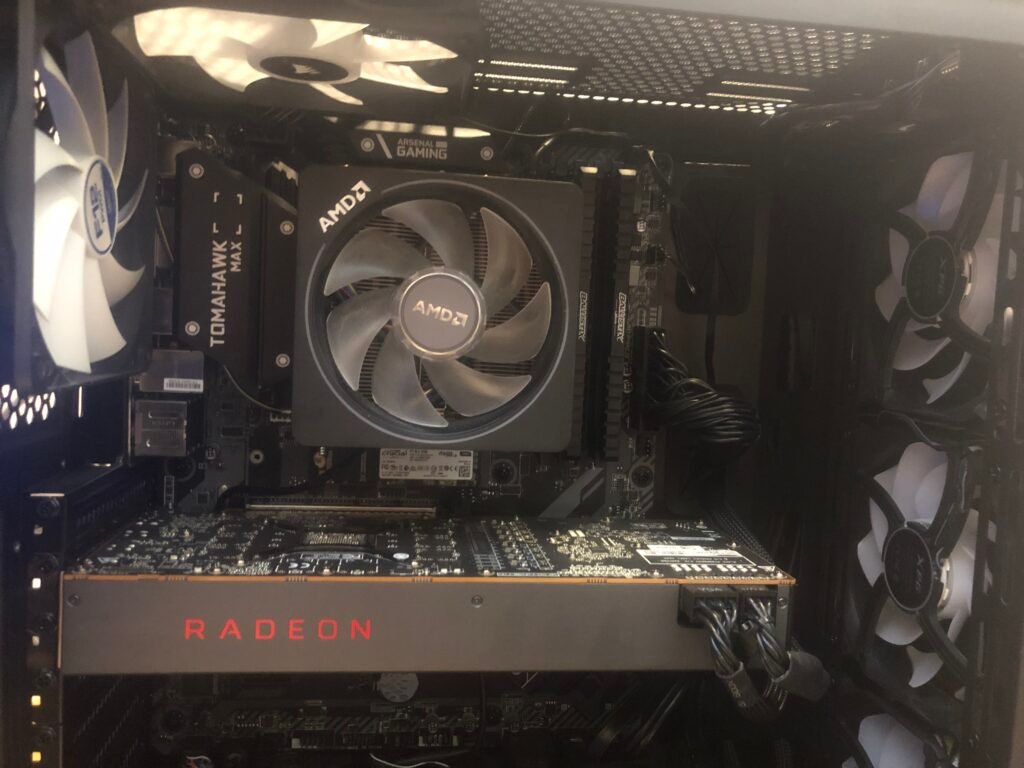
Test 2: Three Intake Fans OFF and Two Exhaust Fans ON at 50% Speed
This is simply where I completely disable my three front fans so they are not spinning and just keep the two exhaust fans at the back on.
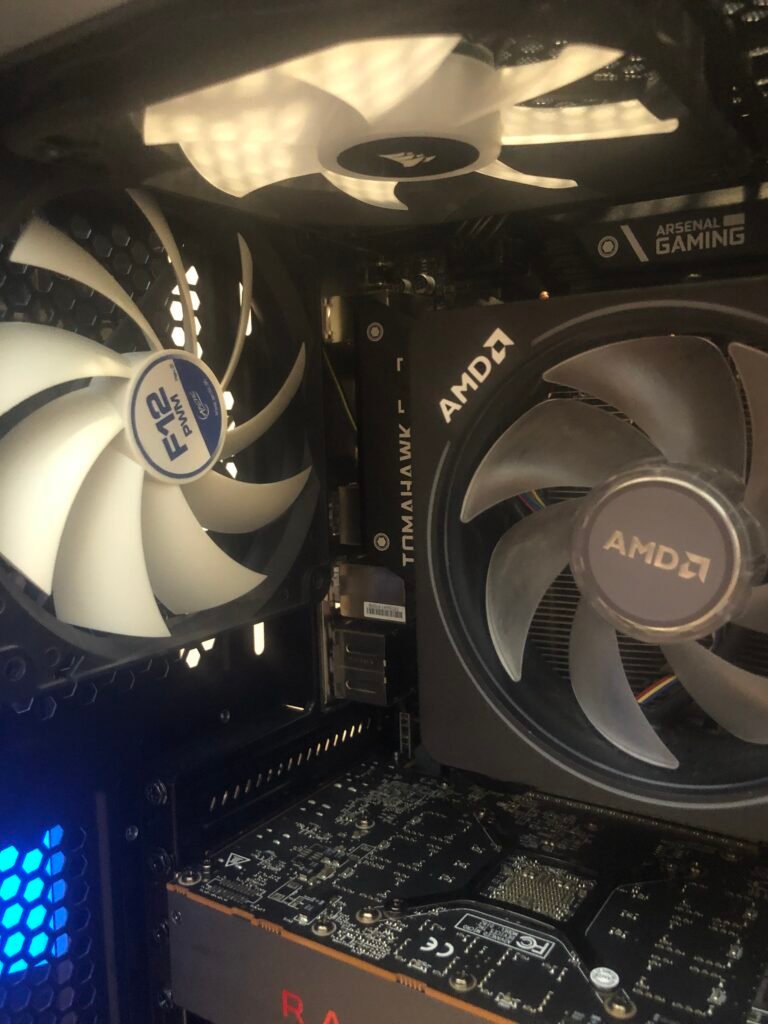
Test 3: Three Intake Fans ON and Two Exhaust Fans OFF at 50% Speed
This is where the three intake fans are now on and the two 120mm exhaust fans are disabled.
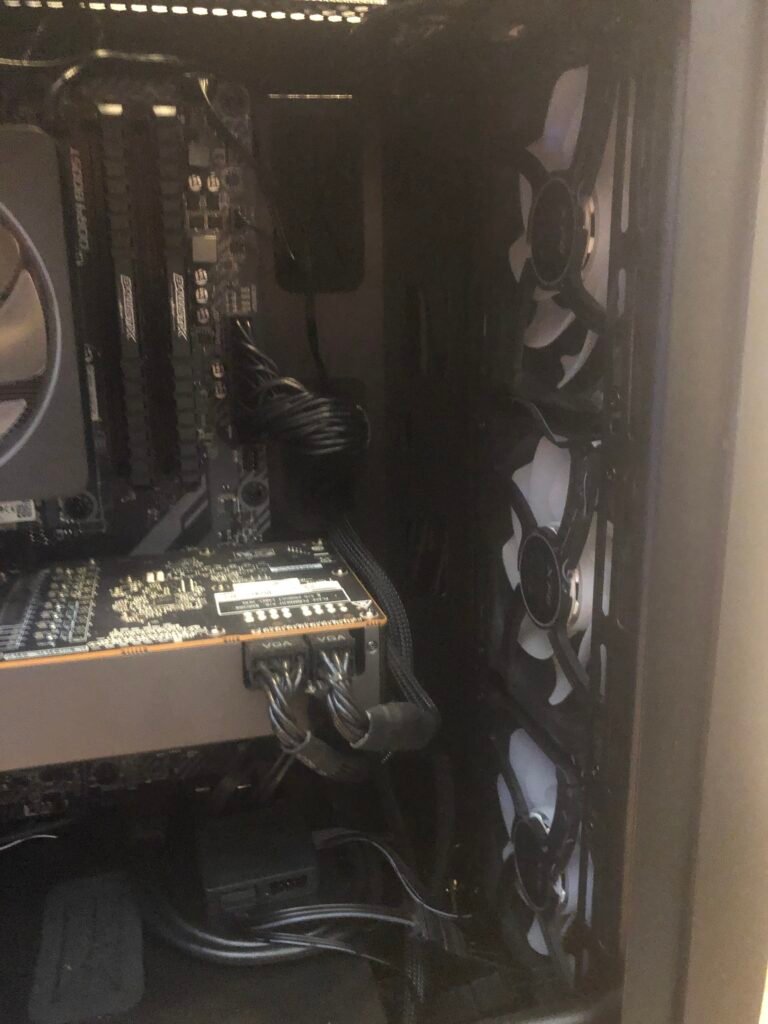
The Results – Benchmarking Different Fan Configurations in my Gaming PC
System Temperature Benchmark
The system temp benchmark should give a decent idea of how the average internal temp of the pc case is doing while the pc is operating. What’s interesting is that the benchmark where all fans are on averaged 50.8°C while having ONLY the exhaust fans on and none of the three intake fans, it performed a negligible 0.5°C worse. I would equate this to actually being about equal in terms of performance, which is surprising. Now, if you only have the intake fans ON and the exhaust fans off, this is where temperature performance took a major hit, we’re talking a 9.4°C hit in terms of overall System Temps. The moral of the story, in this particular setup, the exhaust is very important!
CPU Temperatures (Using average Die Temps) Benchmark
Moving to CPU temps, I focused on the average DIE temps, which gives a decent overview of how my CPU was performing in terms of how hot it got. Overall, with no surprise, temps were hottest using Prime95 (a primarily CPU stressing benchmark), however on average again, having only the intake fans on with NO exhaust, performed on averaged 9.1°C. This is literally only 0.3°C less than the overall system temps, which is very surprising. Again, the moral of the story is that exhaust fans are very important in my current setup.
GPU Temperature Benchmark
Now finally, the GPU temps. I do want to note that my GPU is an RX 5700 with a blower fan here. That means that it exhausts (or attempts to) most of it’s own heat out the back of my case. However, again the overall average pointed well towards the exhaust fans needing to be active in order to have optimal temp results. In fact, in this scenario, having only the exhaust fans operational resulted in the best thermal performance by 0.6°C – again a bit of a margin of error here.
Conclusion on How to Benchmark Your Gaming PC Temps
I hope you’ve gleaned a bit of insight into how you might benchmark your gaming pc’s temps. And I hope that you’ve seen that based on the results of my test benchmarks above, the results may be surprising depending on your current setup.
In my particular case, it’s 100% obvious that my exhaust fans play an integral part in how my gaming PC manages its internal temperatures, not only on average internally, but with integral hardware components like my CPU and GPU.
With the above though, you should be able to take your current gaming PC’s hardware, and determine how you can maximize your temperatures given multiple scenarios, as each gaming pc will ultimately be unique. Do keep in mind though, that the number one thing to keep in mind is that you are keeping each of your individual hardware components temps below their maximums, and that’s really what matters.
Another thing to keep in mine is whether your PC is setup to have Positive Airflow, or Negative Airflow, but that’s an article I’ll be posting soon!
Have any questions on how to benchmark your gaming PC’s temps, leave them below!

